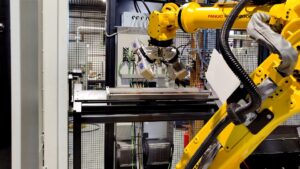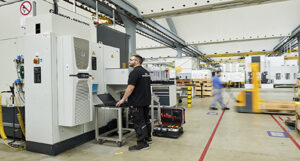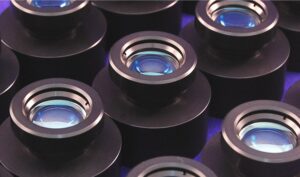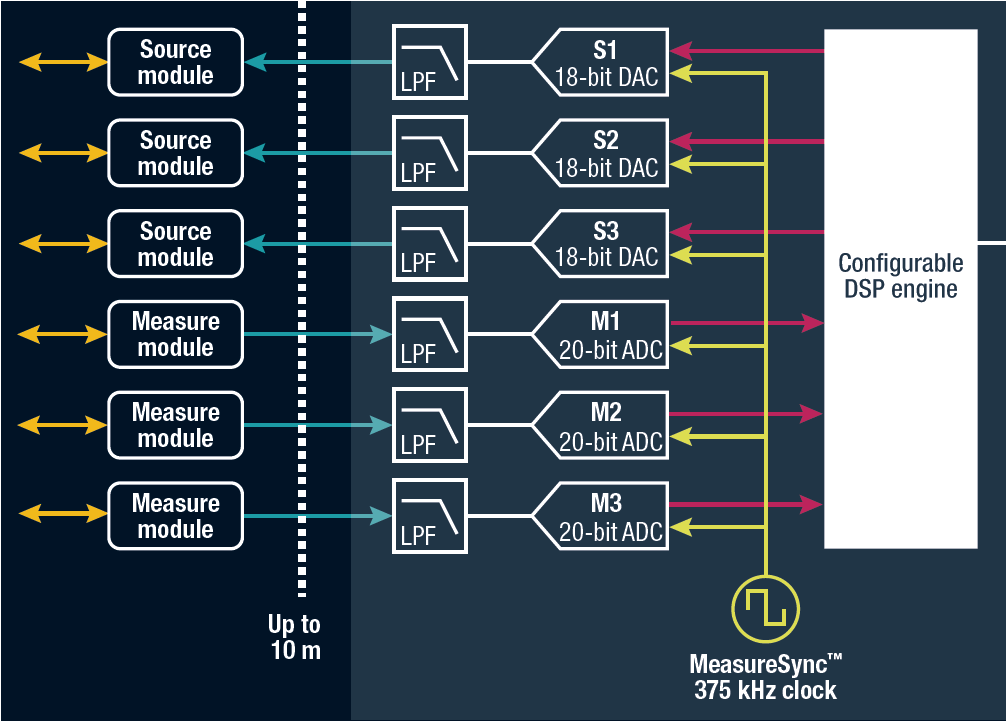Mills CNC, a machine tool supplier based in Leamington Spa, has chosen to use a laser triangulation sensor from Micro-Epsilon in one of its bespoke machine tool automation cells (SYNERGi) with a primary focus on inspecting large, hot rolled steel railway fishplates.
The triangulation sensor, which is mounted on a Fanuc robot end effector, intricately measures the contours – the ‘bend’ and ‘twist’ – of the fishplates to ensure they are within the required manufacturing tolerances. The automation cell then places the fishplates into a Mynx 5400 to be machined.
One of the fastest growing machine tool companies in the UK, Mills CNC is the sole provider of Doosan Machine Tools within the nation and has machines to suit all the manufacturing sectors including aerospace and defence, power generation, motorsport, oil and gas, medical, automotive and general precision component manufacture. The company’s reputation is built on the quality, reliability and performance of the Doosan machine tools it sells.
Established in 2018, Mills CNC Automation was created to project Mills CNC and its customers businesses forward. Mills CNC saw automation as key to increasing manufacturing productivity and output for all customers, both old and new. The division, which is located at Mills CNC’s Technology Campus facility in Leamington Spa, has two principal specialisms, Industrial Robots and Collaborative Robots.
Chris Ingham, Controls & Systems Engineer at Mills CNC Automation comments: “At the Technology Campus, we’ve developed a number of automation systems and machine tool demonstrations for our customers to view. We are currently testing and commissioning an automation system for a customer who needs to inspect railway fishplates manufactured by a hot rolling mill. The project began in late 2020 and the inspection system uses a laser triangulation sensor from Micro-Epsilon.”
Fishplates are metal bars that are bolted to the end of two rails to join them together in a railway track. The hot rolling mill produces the high ductile steel fishplates in four different product groups that vary in length from 0.5m up to 1.0m. Mills CNC Automation has custom designed, and built, a fully automated machine tool pick-and-place system for inspecting the fishplates.
Easy integration was key
The optoNCDT 1750 laser triangulation sensor from Micro-Epsilon is mounted on a robot end effector in between two magnetic grippers. The laser sensor measures the fishplate in eight different positions (on average) and outputs this data via the Micro-Epsilon IF2030 EtherNet I/P module into the Fanuc robot controller.
This data is then utilised by Mills CNC’s own custom analysis software with the results displayed on the machine tool HMI. The data is used to verify that the fishplates are within tolerance in all three planes, including whether ‘bend’ and ‘twist’ tolerances have been exceeded.
As Chris Ingham explains: “If the measurement data shows that a fishplate is out of tolerance, the part is rejected before machining and returned to the rolling mill. The fishplates need to be within a tolerance of 2mm over a length of one metre, but we needed a sensor that was reliable and capable of communicating with our Ethernet I/P network. These factors, as well as a favourable price-performance ratio, were critical for us when searching for a suitable sensor solution.”
The optoNCDT 1750 is a laser triangulation sensor with integrated controller that is perfect for mounting on a robot end effector. It is also suitable for high speed distance, displacement and position measurements in a wide range of applications, including automation, machine building, electronics production, packaging, automotive and process manufacturing. Mills CNC is using a sensor with a measuring range of 750mm.
The optoNCDT 1750 series is also available in measuring ranges from 2mm up to 750mm. The sensor’s measuring rate is continuously adjustable up to 7.5kHz and can be individually adapted to suit each measurement task. Data output is via analogue or digital RS422 interface. Due to the Advanced Real Time Surface Compensation (A-RTSC) feature, the sensor operates almost regardless of the target material and colour. The exposure time or amount of light produced by the laser sensor is optimally matched to the reflection characteristics of the target surface, which enables reliable measurements even of difficult, changing surfaces.
The IF2030 module from Micro-Epsilon converts the sensor’s RS422 output for integration to industrial networks and is available for Profinet or Ethernet/IP. The IF2030 EtherNet I/P interface module is a single channel system that is compatible with Micro-Epsilon sensors that output data via their RS422 or RS485 interface. The interface module supports data rates up to 4 MBaud and can be installed in switching cabinets via a DIN rail.
“When I first contacted Micro-Epsilon, their application know-how and experience was evident. Once I had fully explained our application to Micro-Epsilon, they advised me on which type of measurement technique would be most suitable, in this case laser triangulation. From there, they advised me on which sensor product would best meet our needs. The only aspect of the sensor solution that we decided to carry out ourselves was to build a custom enclosure for the sensor that provides additional protection from machine tool coolant mist,” says Chris Ingham.
He concludes: “The sensor is performing well and is providing reliable measurement data. During the machine test and commissioning phase, the customer has been sending us different groups of parts to inspect and so we’ve really been able to put the sensor through its paces. We’ve been very impressed with the sensor and technical support when we’ve required it. We look forward to working with Micro-Epsilon again in the future.”
 Instrumentation Monthly Test | Measurement | Control
Instrumentation Monthly Test | Measurement | Control









